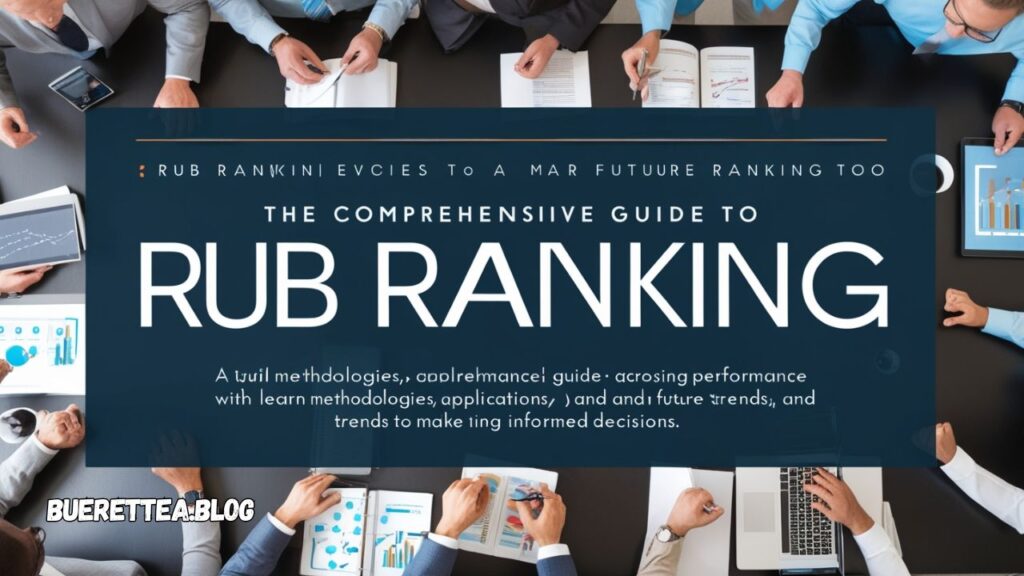Discover the comprehensive guide to RUB ranking, a vital tool for evaluating performance across industries. Learn methodologies, applications, and future trends of RUB rankings to make informed decisions.
Introduction to RUB Ranking
RUB ranking is a crucial metric for evaluating and comparing various entities, whether they are institutions, businesses, or individual performers. Understanding RUB ranking can provide valuable insights into performance standards, benchmarks, and how different elements stack up against each other. Whether you’re a seasoned analyst or a curious beginner, this guide will help you dive deep into the concept, applications, and implications of RUB ranking.
In this blog, we will explore the historical background, methodologies, real-world applications, and future trends associated with RUB ranking. This comprehensive guide aims to provide an in-depth look at how RUB rankings are calculated, why they matter, and how you can leverage them effectively.
Table of Contents
What is RUB Ranking?
RUB ranking refers to a standardized system of evaluating and ranking entities based on specific criteria. The acronym “RUB” often symbolizes a unique framework or methodology designed for ranking purposes. RUB rankings are used across industries, from education and business to sports and entertainment, to measure performance, quality, and impact.
Why is RUB Ranking Important?
- Standardized Measurement: RUB ranking offers a consistent framework for comparison.
- Informed Decision-Making: Enables stakeholders to make data-driven decisions.
- Benchmarking: Helps identify leaders and laggards in a given field.
- Transparency: Provides clarity and accountability through objective metrics.
Real-World Examples of RUB Rankings
- Academic Institutions: Universities ranked by their RUB scores for research output and teaching quality.
- Businesses: Companies evaluated based on innovation, customer satisfaction, and market share.
- Sports Teams: Teams ranked by performance metrics such as wins, losses, and player statistics.

The Methodology Behind RUB Rankings
Understanding how RUB rankings are calculated is essential to appreciate their significance. Below, we break down the common methodologies used in RUB ranking systems.
Key Factors in RUB Rankings
- Criteria Definition: Identifying what will be measured.
- Weighting System: Assigning importance to different criteria.
- Data Collection: Gathering accurate and reliable data.
- Scoring Model: Applying mathematical models to compute scores.
- Normalization: Adjusting scores to ensure comparability.
- Final Ranking: Compiling results into a ranked list.
Common Techniques
- Quantitative Analysis: Using numerical data to create scores.
- Qualitative Assessment: Incorporating expert opinions and reviews.
- Hybrid Models: Combining quantitative and qualitative methods for a balanced approach.
Challenges in RUB Ranking Methodologies
- Data Availability: Limited access to comprehensive datasets.
- Bias and Subjectivity: Risk of skewed results due to subjective criteria.
- Dynamic Changes: Difficulty in accounting for rapidly changing factors.
How to Interpret RUB Rankings
To make the most of RUB rankings, it is important to understand how to interpret them effectively.
Key Considerations
- Rank Position: Higher ranks typically indicate better performance.
- Score Differences: Analyze the gap between consecutive ranks.
- Context: Consider the criteria and methodology behind the ranking.
- Trends Over Time: Look at historical data for patterns and shifts.
Common Pitfalls to Avoid
- Overreliance on Rankings: Rankings are tools, not absolute truths.
- Ignoring Methodology: Always review the methodology before drawing conclusions.
- Assuming Universality: Not all ranking systems are applicable across contexts.
Applications of RUB Rankings
RUB rankings have wide-ranging applications, impacting various sectors and decision-making processes.
In Education
- University Selection: Students and parents use RUB rankings to choose institutions.
- Policy Formulation: Governments leverage rankings to allocate funding and resources.
In Business
- Competitive Analysis: Companies benchmark themselves against industry leaders.
- Investor Decisions: RUB rankings influence investment opportunities.
In Sports
- Team Evaluations: Rankings highlight top-performing teams.
- Player Comparisons: RUB scores are used to rank individual athletes.
In Entertainment
- Box Office Metrics: Films ranked by revenue and audience reviews.
- Streaming Services: Content ranked by popularity and ratings.

The Future of RUB Rankings
As technology advances and data analytics improve, RUB rankings are poised for significant evolution. Here are some trends shaping their future:
Integration of AI and Machine Learning
- Enhanced Accuracy: AI can process vast amounts of data more efficiently.
- Dynamic Updates: Real-time ranking adjustments based on live data.
Personalization
- Customized Rankings: Tailoring rankings to individual preferences and needs.
- User-Generated Input: Incorporating feedback from end-users to refine criteria.
Globalization
- Cross-Border Comparisons: Expanding RUB rankings to include international entities.
- Standardized Metrics: Developing universal frameworks for global applicability.
Ethical Considerations
- Transparency: Ensuring methodologies are open and accessible.
- Bias Mitigation: Addressing inherent biases in data and criteria.
Frequently Asked Questions (FAQs)

What does RUB stand for?
RUB typically represents a specific framework or methodology in ranking systems, but its exact meaning may vary based on context.
How are RUB rankings calculated?
RUB rankings are calculated using a combination of criteria, weighting systems, and data analysis techniques. The specific methodology depends on the ranking’s purpose.
Why do RUB rankings matter?
RUB rankings provide a standardized way to evaluate and compare entities, helping stakeholders make informed decisions.
Can RUB rankings be biased?
Yes, like any ranking system, RUB rankings can be influenced by biased criteria or subjective methodologies. Transparency and rigorous validation are essential to mitigate this.
Where can I find reliable RUB rankings?
Reliable RUB rankings are published by trusted organizations, industry analysts, and academic institutions. Always review the methodology and source credibility.
For additional insights, visit this article.
Conclusion
RUB ranking is a powerful tool for evaluation and comparison, offering valuable insights across various domains. By understanding its methodologies, applications, and implications, you can leverage RUB rankings to make informed decisions and stay ahead in your field.
Whether you’re analyzing academic institutions, businesses, or sports teams, RUB rankings provide a structured and reliable way to assess performance and quality. As technology and methodologies evolve, the relevance and accuracy of RUB rankings will only continue to grow.
Stay informed, stay analytical, and harness the power of RUB rankings to achieve your goals.
